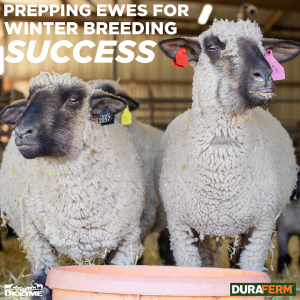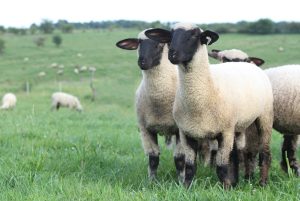
We typically think of springtime as a time of birth and growth. Gardens are planted, flowers bloom and newborn lambs and kids are jumping around on the farm. However, with changes in technology and the evolving demand for lambs and goats at various times of the year, more and more producers have started breeding in the late spring and early summer to lamb and kid in the fall.
Advantages to Fall Lambing, Kidding
There are definite advantages of parturition in the fall. Producers can take advantage of the forages available for grazing during late gestation and early lactation that aren’t accessible in the winter. In the same sense, weather is generally feasible for pasture lambing and kidding, which can lead to healthier flocks and herds. Additionally, there are usually fewer challenges with internal parasite control or predators like coyotes in the fall. Finally, producers will have more time to feed their lambs and goats to heavier weights for the spring market, which is typically a time of higher demand.
Although many benefits to fall lambing and kidding exist, that means getting ewes and does bred in the heat of late May into June, not the easiest task. Does and ewes are considered seasonal or short-day breeders so they are not naturally in estrus during the long periods of daylight occurring when it is time to breed for fall babies. However, it is possible.
Preparing Does, Ewes for Summer Breeding
The most important factors to ensure success with your summer breeding is to make sure your females are in good nutritional shape and in optimum health. You will want to make sure they are in good shape, but not too fat, as over conditioned animals often have lower conception rates.
“Two weeks before breeding, I just let them be sheep to keep their stress as minimal as possible. I give them hay to maintain them and keep them full. Next, I focus on their health. To prevent any hoof rot issues, I keep them in a dry lot. I make sure they are all sheared prior to breed to help prevent flies, sheep keds and lice. And I give them a pour on called UltraBoss,” said Greg Beatty, owner of Beatty Club Lambs, Indiana, Pennsylvania.
Another challenge with breeding sheep in the hot and wet months is pregnant ewes contracting Cache Valley Virus, transmitted through mosquitoes. Beatty said anything producers can do to keep mosquitoes at bay is worth the effort to save one or more lambs each year. Cache Valley Virus can cause infertility, abortion, dystocia, stillbirth, premature birth and a variety of deformities, often leading to death.
Typically, a body condition score of 2 is ideal for ewes when getting ready to breed. Beatty said if he is dealing with donor ewes and recips, he does offer them about one pound of grain per day for two weeks prior to breeding. This added nutrition helps with both embryo production, and an increase in protein will help the recips cycle and settle better.
Getting the Nutrition Right
One way to help ensure that your ewes and does have the best nutrition possible at breeding season and year-round is with the DuraFerm® line of minerals. Both DuraFerm® Sheep Concept•Aid® and DuraFerm Goat Concept•Aid® come in a loose mineral form and a tub that offers added protein, ideal for breeding season. DuraFerm Concept•Aid is recognized as a breeding mineral that contains high levels of Vitamin E for reproductive tract repair, balanced levels of high-quality vitamin and minerals required for growth, breeding and parturition and Amaferm® to help livestock utilize and convert forage more efficiently. Amaferm is a precision prebiotic that impacts intake, digestibility and absorption of feedstuffs.
The new DuraFerm Goat Concept•Aid Protein Tub contains 20% added natural protein. The DuraFerm Sheep Concept•Aid Protein Tub adds 16% natural protein to your flock’s diet.
DuraFerm Sheep Concept•Aid also comes with a HEAT® package, designed to feed anytime the temperatures reach 70 degrees or hotter. With a combination of plant extracts including capsaicin, cloves and garlic, HEAT is research-proven to regulate the core body temperature. The garlic is a natural insect deterrent, something sheep producers should be aware of.
Timing is Everything
The newest resources that DuraFerm offers are gestation calculators for both does and ewes. These interactive, online tools allow the producer to enter their breeding dates to generate an expected lambing or kidding dates, with ewe and doe gestation calculated at 145 and 150 days, respectively. These calculators also suggest the best time to start feeding the DuraFerm minerals to get the most advantageous results. In addition to the calculators, a downloadable gestation table is available, that makes it handy to print and keep in your barn or office. View these tools at www.duraferm.com under the “resources” tab. Breeding off season might seem like a risk or a challenge, but with ideal health and nutrition, most risks pay off over time. Make sure your flock and herd have the nutrition they need and deserve to get bred, stay bred and deliver healthy, vigorous offspring. Give your does and ewes the Amaferm advantage.

